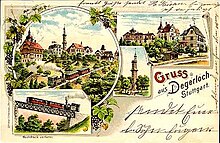Filderbahn Society
The Filderbahn-Gesellschaft , abbreviated FBG , is a former German railway company . It was on July 14, 1884 for the development of the south of Stuttgart nearby Filderstadt - Plateau founded and was the first private railway in Württemberg . The FBG also operated the Stuttgart cog railway, the first narrow-gauge railway in Württemberg.
After taking over the concession for the Strohgäubahn under construction, the ordinary general assembly of May 29, 1905 decided to change its name to Württembergische Nebenbahnen (WN). In 1920 the company sold the cog railway and the routes around Möhringen to the city of Stuttgart. The remaining WN lines have been part of the Württembergische Eisenbahn-Gesellschaft mbH since 1984 .
prehistory
At the end of the 19th century, the Filder were in the traffic shadow of the railway lines of the Royal Württemberg State Railways starting from Stuttgart . However, as there were close economic ties between the royal seat of Stuttgart and the Filder communities, a rail link was urgently required.
Rack railway Stuttgart – Degerloch
In 1884 the meter-gauge rack railway from Stuttgart to Degerloch opened on the basis of a private initiative (among others by Emil von Kessler , director of the Esslingen machine works ) . The route, equipped with a rack according to the Riggenbach system, was 1.93 kilometers long and is considered to be the "nucleus" of the later FBG network.
Degerloch – Hohenheim steam tram
Four years later, the adhesion section was added from the mountain station of the rack railway in Degerloch to Hohenheim . It consisted of the two sections of the route Degerloch – Möhringen and Möhringen – Hohenheim . The new line was also meter gauge and was operated as a steam tram .
Expansion of the network
Extensions from Möhringen to Vaihingen on the one hand and via Echterdingen to Neuhausen auf den Fildern on the other followed. They were also made meter-tracked.
Other changes were the later electrification of the network, the partial conversion to standard gauge and the construction of the Neue Weinsteige line from Degerloch to Stuttgart, completed in 1904 .
With the exception of the Neuen-Weinsteige-Linie, both passenger and freight traffic took place on all routes . Standard-gauge freight wagons for the narrow-gauge routes were handed over at the Vaihingen state train station and transported on three- rail tracks via Möhringen to Degerloch or Hohenheim.
literature
- G. Bauer, U. Theurer, C. Jeanmaire: Trams around Stuttgart . Verlag Eisenbahn Gut Vorhard, Villigen / Aargau 1984 ISBN 3-85649-047-7 , p. 12ff.
- City of Filderstadt, history workshop Filderstadt (ed.): The Filderbahn . (Volume 4 of the Filderstädter series of publications on local and regional studies) Filderstadt 1990 ISSN 0935-3143 .
- Nikolaus Back: 100 years of the Filderbahn . In: Schwäbische Heimat , 1998/1, pp. 56–66.
Web links
- Private homepage of the Filderbahn project group
- Private website for the Filderbahn routes with a focus on the rack railway
- Early documents and newspaper articles on the Filderbahn Society in the 20th Century press kit of the ZBW - Leibniz Information Center for Economics .
Individual evidence
- ↑ Glems and Würm Gau newspaper, June 1, 1905






